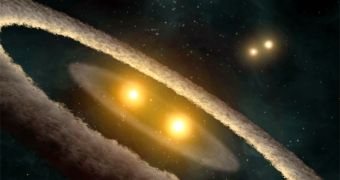It's a common sight in numerous science fiction stories and movies: a planet with two suns (often of drastically different colors) producing double shadows, multiple sunrises and sunsets and other exotic phenomena that would appear utterly alien to us Earthlings, like Luke Skywalker's home planet, Tatooine.
Now astronomers may have discovered a beautiful quadruple star system that has not two, but four sunsets and sunrises. They also found a dusty disk that could be home to a planet in the making.
The most interesting thing is the possibility of such a planet already existing in the system, since they detected a gap in the disk that could be evidence of one or more immature "protoplanets" carving out lanes in the dust.
The view from the surface of the planet would be really stunning, as the light of the four suns would alternatively shine on it. One pair of suns would blaze brightly, while the other pair, gravitationally bound to the first pair, would appear as little more than faint pinpoints of light. The show would be spectacular, as the two main suns would eclipse each other and rise and set consecutively.
The system was detected by using the infrared eyes of NASA's Spitzer Space Telescope and the disk is swirling around a pair of stars in the quadruple-star system HD 98800, located 150 light-years away in the constellation TW Hydrae. It is still relatively young, at 10 million years old.
Quadruple star systems are quite rare, but double ones are more common, astronomers estimating that 2/3 of stars like our sun have at least one stellar companion. Astronomers have theorized that planets could form with little trouble in two-star systems, called binaries, despite the more complex gravitational tugging.
So all this evidence shows that Skywalker's home planet is not so much the product of a writer's imagination, as it could be a cosmological probability.

 14 DAY TRIAL //
14 DAY TRIAL //